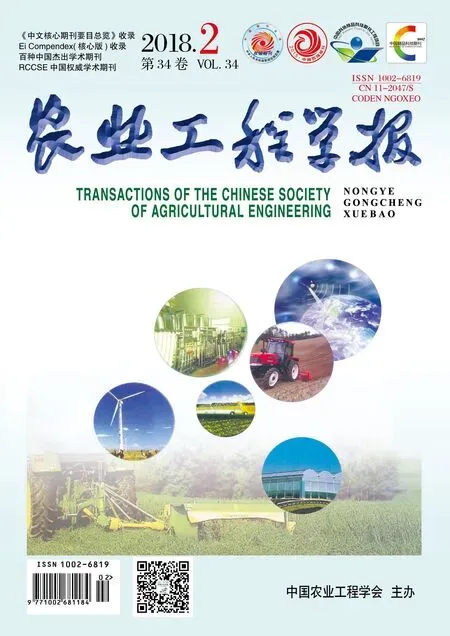生猪养殖业污水排放智慧监管系统的设计与实现
武新梅,徐爱俊,周素茵
生猪养殖业污水排放智慧监管系统的设计与实现
武新梅,徐爱俊,周素茵※
(1. 浙江农林大学信息工程学院,杭州 311300; 2. 浙江农林大学浙江省林业智能监测与信息技术研究重点实验室,杭州 311300)
为了对生猪养殖业污水的治理过程进行监控和违规排污预警,该文提出了养殖污水实时监管策略,设计并实现了生猪养殖污水治理智慧监管系统。该系统通过信息采集模块收集养殖污水排放的实时数据,实现养殖污水实时数据监测、预警分析等功能。其中集中治理的监管是根据安装在槽罐车上的GPS数据和污水集中处理厂的信息,判断污水是否被运送到指定地点排放;工业治理的监管是采用模糊推理理论,以监管因子的浓度偏差及偏差变化率为输入量,相应的污水预警等级作为输出量,对监管因子进行模糊化及逻辑推理,建立相应的模糊监管子系统,生成工业治理监管规则及策略;针对生态治理的监管,构建了相应的监管策略和Ecological数学模型,该模型以监管策略为依据,对实时数据进行定性与定量分析预测,实现对偷排漏排、满溢等违规排污现象的判断。试验结果表明,系统预警准确度为96.17%,平均误差时间为33.22 s,违规排污量平均值为15.77 L,能够满足养殖污水排放监管要求,对提高监管效率具有重要意义。
污水;排放控制;设计;生猪养殖;模糊推理;智慧监管;监管系统
0 引 言
生猪养殖业日趋集约化和规模化,这在促进农业的产业化发展的同时,养殖废水也对生态环境构成了严重的威胁[1-3]。养殖污水的监测成为社会关注的重要话题。生猪养殖业污水治理方式主要分为生态治理、工业治理和集中治理[4-8]。生态治理指生猪养殖企业将污水排往沼液池,通过沉淀和消纳地等来实现污水的循环利用;工业治理指生猪养殖企业自建发酵池,通过微生物发酵的方式来治理污水;集中治理指将污水运输至污水处理厂集中处理。不同的处理方式原理及排放流程有所不同,其监管方式也有所差异。
传统的养殖污水达标排放检测是基于化学方法,该方法需要消耗试剂,容易造成二次污染[9-10]。Matcalf等[11]通过用水量折算污水排放量,采集污水进行水质分析,这种方法测量周期长、精度低,无法实现水体污染的动态监测。韩红桂等[12]提出了一种基于模糊神经网络的软测量方法,用于测量污水处理过程中出水NH4-N的值。神经网络法的软测量是一种大样本学习方法[13-14],由于实际应用中样本数量有限,模型精确度往往不高。为了能够高效地监测养殖污水的排放,解决监管过程中存在的取证难度大、实时性差等问题,将物联网与智能监管方法有机结合,构建基于无线传感网络与智能监管相结合的污水监管系统是未来发展的趋势。Li等[15]构建了污水质量监控系统,解决了污水监测传感器中可能存在严重污染物和生物淤积等问题,从而提高对污水质量监测的实时性。近年来中国畜禽养殖业信息化发展速度也相对较快[16-20]。李慧等[21]开发了一种基于物联网的水产养殖远程监控系统,通过无线传感网络实现水质环境的远程控制,但由于环境因子响应速度慢、抗干扰能力差使得监控的实现仍存在问题。马从国等[22]研制了基于模糊控制方法和无线传感网络相结合的水产养殖池塘溶解氧智能监控系统,为解决非线性、大时滞复杂对象的控制问题提供一种新思路。谢秋菊等[23]提出了猪舍多环境因子模糊控制系统及策略,根据设定值对猪舍内环境因子进行自动控制,模糊控制方法的引入有助于实现猪舍环境因子的调控,使系统运行更加高效稳定。
本文在分析现有污水治理方式的特点和传统养殖污水监测方式不足的基础上,设计并实现了生猪养殖污水治理智慧监管系统,实现对养殖污水排放的实时监管与预警;基于模糊推理理论建立工业治理模式下的污水监管模式,对监管因子进行模糊化及逻辑推理,制定相应监管因子的监管策略及规则;针对养殖污水生态治理本文提出了Ecological模型,模型以生态治理监管策略的工作原理为基础,对监测数据进行定性与定量分析、预测。该系统的实现对提高污水监管效率具有重要意义。
1 系统分析与设计
1.1 总体框架
生猪养殖污水智慧监管系统以污水的处理与排放过程为研究对象,利用传感器、GPS、视频监控设备获取实时数据,结合历史数据及实地调研数据构建云数据库。将云数据库与3种治理方式的监管指标体系相结合,通过特定的污水监管策略实现生猪养殖业污水排放数据的分析与预警,并利用预警决策分析方法实现系统警报推送机制。另外,预警决策结果也将作为评价企业信用等级的依据保存至历史数据库,用于实现对严重违规排放企业的重点监管。具体监管框架如图1所示。

图1 生猪养殖污水智慧监管系统总体架构
1.2 数据采集系统设计
污水排放数据采集系统主要由传感器、微处理器和GPRS无线传输模块组成,其框架如图2所示。各传感器及仪表与微处理器之间通过RS485(采用MODBUS协议)进行通信。微处理器与GPRS无线传输模块通过RS232协议进行通信。系统采集的数据直接传送到云服务器,作为整个监管系统的基础实时数据。
信息采集终端使用的设备信息如表1所示。不同污水治理方式使用不同类型的传感器或GPS定位设备对污水排放进行动态监测,根据数据的实际变化情况,生态治理和集中治理的监管设定采集周期为10 min,工业治理采集周期为2 h。采集的数据主要有污水氨氮含量、COD值、沼液池液位、流量、槽罐车经纬度等。

注:COD为化学需氧量,BOD生化需氧量,SS悬浮量。

表1 设备基本信息
1.3 养殖污水监管系统设计
1.3.1 监管数据流分析
生猪养殖污水智慧监管系统通过从数据采集终端监听与获取实时数据,根据不同的污水治理方式分析和判断污水排放时间、地点及水质状况等是否满足污水排放要求及环保标准,监测养殖企业是否存在偷排、漏排、满溢、不适宜时间排放及水质不达标等违规排污现象。为了确保养殖污水的正常排放,本节根据污水的3种治理方式的治理流程及特征,分析其数据监管流程,如图3所示。
其中,集中治理模式下,当大于1小于2,大于1小于2时,槽罐车到达污水处理厂,此时若流量值增加,则污水正常排放;若槽罐车到达污水处理厂但值未发生变化或减小则发送设备故障警报。若小于1或大于2,或小于1或大于2时,则说明槽罐车并未到达污水集中处理厂,流量值若发生变化,则说明养殖污水未被运输到指定地点进行排放,此时系统发送实时预警。

注:μ表示安装在槽罐车排污口处流量传感器的值;X1、Y1、X2、Y2分别表示污水集中处理厂范围的最小经度、最小纬度、最大经度和最大纬度;(X, Y)为槽罐车实时位置;h为沼液池深度的90%;hi为第i次获取的液位传感器的数据;F(h, hi)是判断沼液池是否满溢的函数;λ是电机状态,λ=1时电机开启,λ=0时电机关闭;μ0为沼液排放总流量,μ1, μ2 … μn表示各终端流量,M(μ0, μ1, μ2,…, μn)是总流量与终端流量和的关系的判断函数;T(r,t)为排放时间判断函数,r为消纳地所在区域雨量值,t为排放时间。
1.3.2 功能结构设计
生猪养殖污水智慧监管系统主要包括实时数据、视频监控、站点管理、设备管理、数据统计、预警管理6个模块,系统总体功能结构如图4所示。该系统的总体目标是通过对污水排放数据进行处理和分析,达到污水排放的实时监管和违规排污实时预警的效果。在保证养殖企业信息的完整性及可修改性的同时,实现不同治理模式下养殖企业的统一监管。因此,系统功能设计应尽可能使各模块间具有较低的耦合性,模块内部各功能之间具有较高的内聚性,从而提高系统的可扩展性和灵活性。保证各模块在逻辑结构上相互联系,在物理结构上相互独立。
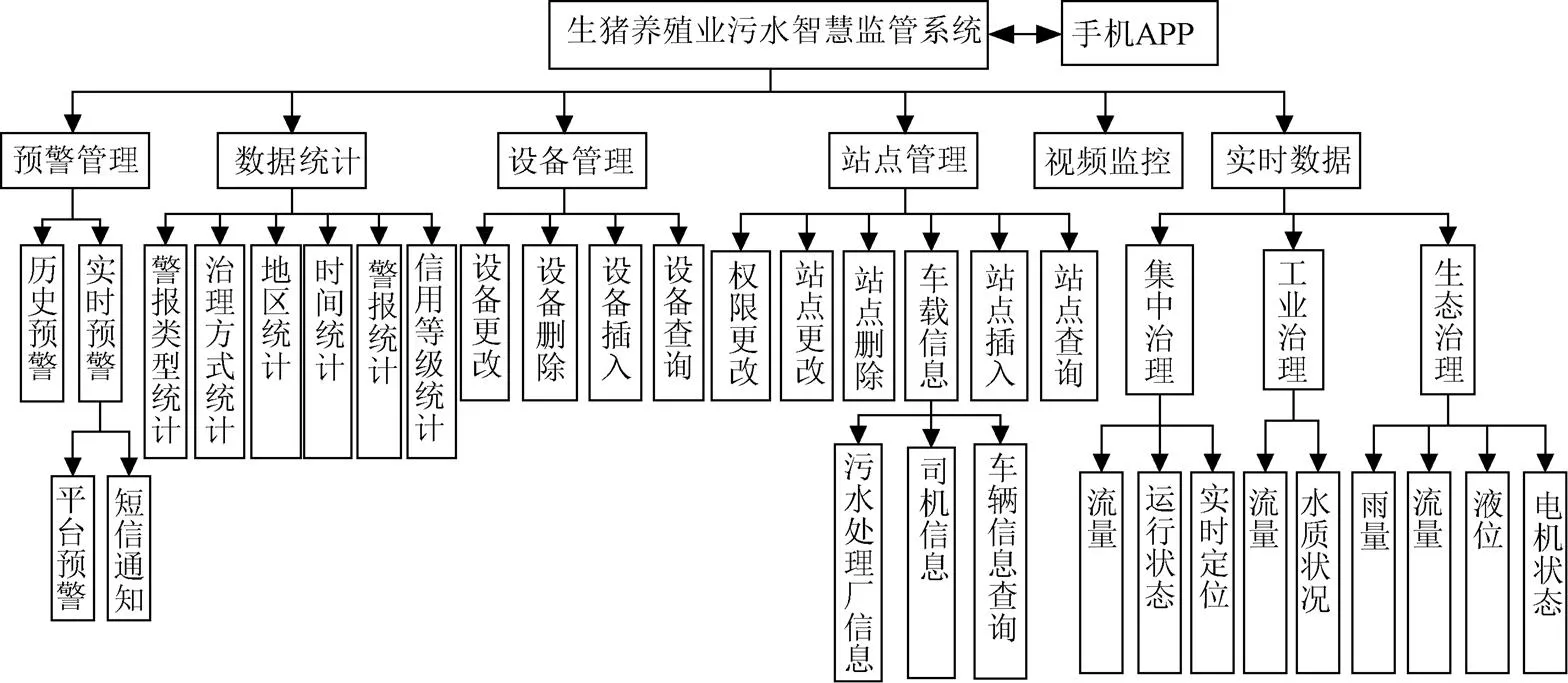
图4 系统功能模块设计
2 系统关键技术
2.1 预警决策
本系统选取负责人身份(监管人员1、企业管理员2)作为预警决策一级指标;1所包含的二级指标及指标因子分别为实时预警1(偷排漏排、不适宜时间排放、设备故障、满溢、水质不达标排放)、企业信用等级2(违规次数、累计污水排放违规时间、累计违规排污量)、警报等级3(违规排污量、违规类型)、警报处理时间4(违规排污对应的处理时间)等作为警报推送决策指标;2所包含的二级指标及指标因子分别为实时预警1(偷排漏排、不适宜时间排放、设备故障、满溢、水质状况)、是否向监管人员发送警报5。预警推送决策的指标体系的一级指标、二级指标和指标因子如表2所示。

表2 预警推送决策指标体系
按照预警推送决策指标体系进行警报推送,当监测到实时数据异常时,将警报信息推送给生猪养殖企业管理人员,同时对该企业的信用等级进行评判,若信用等级较低,则将警报信息推送给监管人员;否则根据排污量、违规排污类型对本次违规等级进行评估,按照监管指标因子及其相应的权重进行等级划分,将警报等级较高的警报信息推送给监管人员;对等级较低的违规排污预警将根据企业管理人员是否对预警做出及时处理决定是否将预警信息推送给监管人员。因此系统中的预警决策是由实时预警、企业信用等级、违规排污等级以及企业管理人员对预警处理的时效性等因素决定的,其警报推送流程如图5所示。
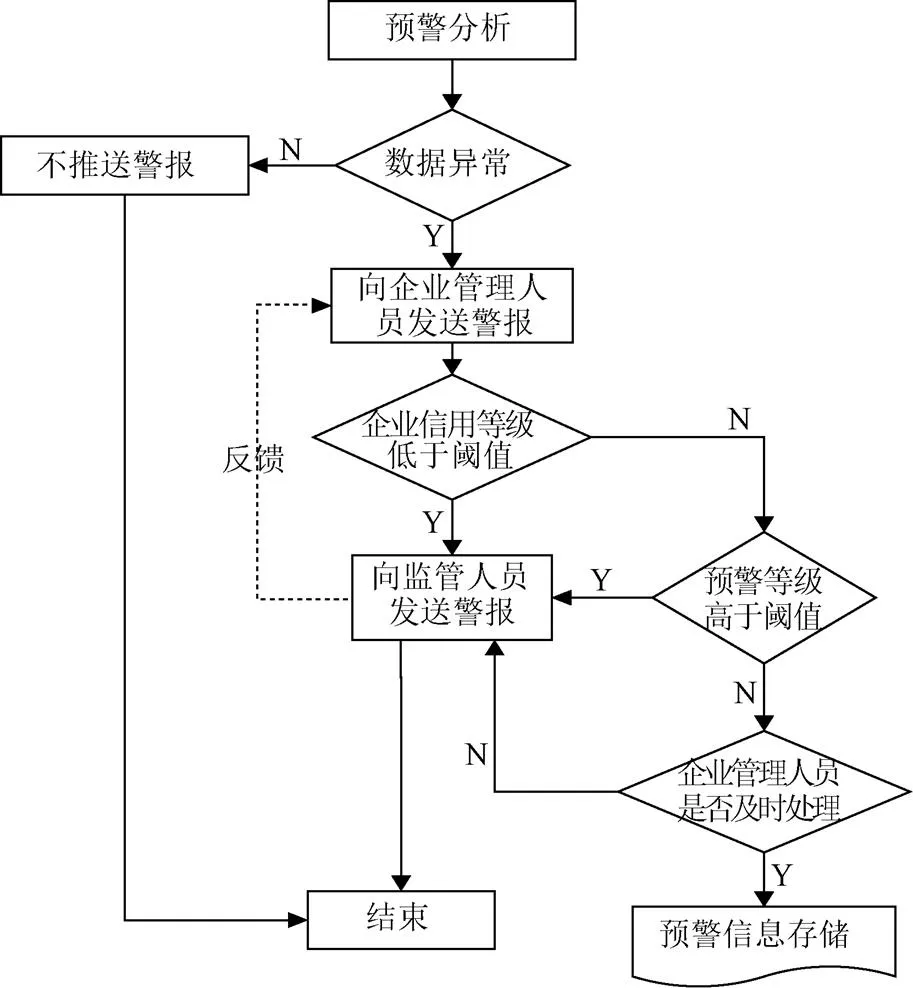
图5 预警推送决策
2.2 工业治理监管策略
根据GB18596-2001《畜禽养殖业污染物排放标准》,本系统选取生猪养殖污水排放时污水中的生化需氧量、氨氮、总磷、化学需氧量、悬浮量作为污水监测指标。工业治理具有监测参数多、非线性及时变等特点,无法建立精确的模型,达不到精确监管的效果。因此,模糊推理方法可以很好的实现生猪养殖污水工业治理的实时智慧监管。
模糊推理是利用模糊数学以人脑的思维方式识别和判断模糊事物或现象,首先进行模糊输入处理,把精确的数值通过模糊化处理转变为模糊集合中的元素,经过模糊推理得到模糊化的输出变量,最后将模糊化的输出变量进行解模糊化,输出精确量[24-25]。养殖污水工业治理模糊推理系统过程如图6所示。生猪养殖污水工业治理监管系统由5个双输入单输出的模糊子系统组合而成,这5个模糊监管子系统分别为悬浮量监管子系统、氨氮监管子系统、生化需氧量监管子系统、化学需氧量监管子系统、总磷监管子系统。模糊监管子系统分别以悬浮量、氨氮、生化需氧量、化学需氧量、总磷的浓度偏差及偏差变化率为输入量,以相应的污水预警等级为输出量,对监管因子进行模糊化及逻辑推理。

注:s,n,b,c,p 分别为SS、氨氮、BOD、COD、TP标准值,e1,e2,e3,e4,e5 分别为SS浓度偏差、氨氮浓度偏差、BOD浓度偏差、COD浓度偏差、TP浓度偏差;ds/dt,dn/dt,db/dt,dc/dt,dp/dt 为单位时间内SS浓度、氨氮浓度、BOD浓度、COD浓度、TP浓度偏差变化率;ks,kn,kb,kc,kp 为输入变量比例因子;u1,u2,u3,u4,u5 为违规预警等级。
本文以悬浮量监管子系统为例对模糊监管系统进行详细解释。以悬浮量浓度偏差和浓度偏差变化率作为模糊推理的输入变量,悬浮量违规预警等级为输出变量1。悬浮量排放标准为小于等于200 mg/L,系统对污水中质量浓度为175~275 mg/L的悬浮量进行监控,设定污水违规排放悬浮量浓度偏差的基本论域为[-25,75],模糊论域为[-1,3],悬浮量偏差输入变量比例因子为k=4/100= 0.02,偏差变化率的论域为[-6,6],输入变量用5个模糊状态表示,悬浮量浓度偏差和偏差变化率模糊集合分别定义为={N, ZO, PS, PM, PB}和={NB, NS, ZO, PS, PB},即={负、零、正小、正中、正大},={负大、负小、零、正小、正大}。输出量模糊集合={NB, NS, ZO, PS, PB},用5个模糊状态分别表示养殖污水违规排污5个等级,即绿色、黄色、橙色、红色、黑色预警,输出量的论域为[1,5]。
选取对称三角形作为输入输出变量的隶属度函数,这样做便于计算,在保证系统灵敏度的同时,兼顾系统的鲁棒性[22-23,25]。
根据生猪养殖污水工业治理特点和监管人员养殖污水监管预警经验构建监管规则表,实现高效模糊推理监管。系统采用重心法对输出量进行解模糊,得到输出变量的精确量。根据推理结果可以确定,不同悬浮量浓度偏差大小和偏差变化率对养殖污水违规排污预警等级均有影响。当浓度偏差为N时,无论>0或<0,推理输出为NB。当浓度偏差为PB时,无论>0或<0,输出为PB。当浓度偏差为ZO、PS、PM时,需要根据浓度偏差变化率来确定预警等级,选择相应的监管规则,确定养殖企业污水违规排放等级。当<0时,说明悬浮量浓度呈减少趋势,预警等级相对较低;当>0时,表明悬浮量浓度呈增加趋势,预警等级相对较高。因此从以上策略分析,根据畜禽养殖业污水排放标准,可以得出25条养殖污水悬浮量模糊推理监管规则,该系统的模糊推理规则表如表3所示。

表3 悬浮量浓度模糊推理规则
2.3 生态治理监管策略
本系统将生态治理模式下生猪养殖企业污水治理智慧监管模型定义为:

Ecological模型处理过程是等于1时,电机开启,此时模型通过将与第次获取的液位传感器监测数据h进行对比判断沼液池是否存在满溢现象,同时通过比较沼液排放总流量0与各终端流量1,2,…,μ之和来判断生猪养殖业污水是否存在偷排、漏排或者设备是否出现故障。另外,Ecological模型通过和的取值判定生猪养殖企业是否在不适宜时间排放。
若待处理数据为,上述模型可以通过具体的函数形式表示,Eco可表达为:

式中表示Full方法,用于判断沼液池是否存在满溢现象;表示State方法用于判断电机状态,函数表示总流量与各终端流量之和的关系;表示Time方法,用于判断养殖污水是否在不正确的时间(雨天或夜间)排放;下面对以上提到的处理方法做具体的解释:




系统采用水平衡方程[26]确定雨季期间污水排放时间间隔()。其公式为

式中表示某次降雨总量,mm;sw为土壤有效储水量,mm;K为作物系数;ET0为参考作物蒸发蒸腾量,mm/d;为地下水补给量,mm/d;为降水入渗系数,指有效降雨量与相应降雨总量的比值。一般取值表4所示[27]。
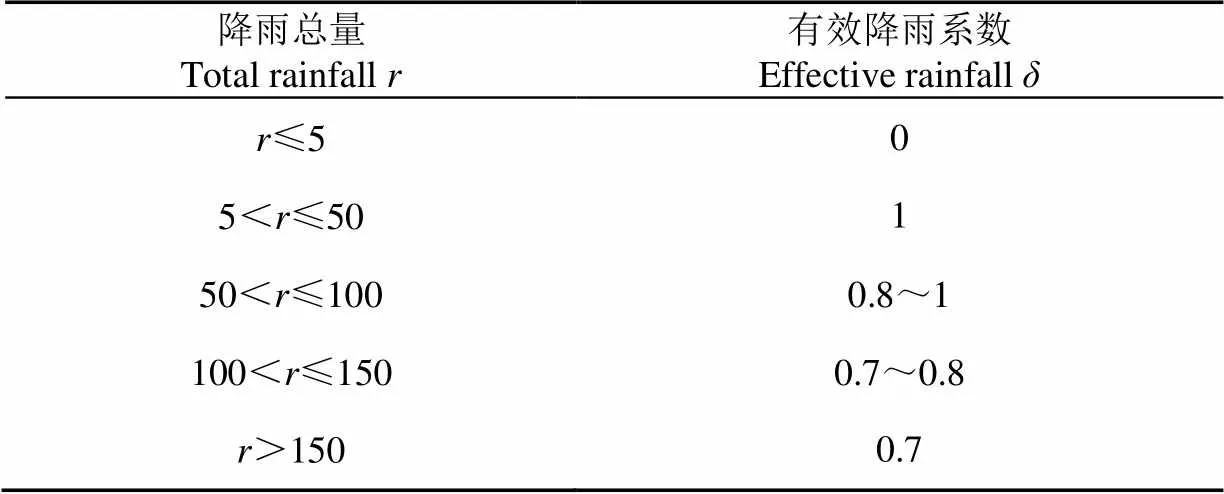
表4 降水入渗系数


式中为作物根系活动层深度,m;为土壤干容重,t/m³;0和FC分别为土壤初始含水率和土壤实时含水率(占干土质量的百分比);G为作物适宜灌溉的土壤水分下限指标,占田间持水率的百分比;为地下水补给系数,与土壤特性、作物类型有关;WD为地下水埋深,m。
ET0根据Penman-Monteith公式计算得出,该公式以能量平衡和水汽扩散化理论为基础,同时考虑作物生理特征和动力学、辐射项参数的变化[28],具有扎实的理论基础和较高的计算精度,在蒸散研究中被广泛应用[29-30]。Penman-Monteith公式为

式(10)中Δ为饱和水气压温度曲线上的斜率,kPa/℃;R为冠层表面净辐射,MJ/(m2·d);为土壤热通量,MJ/(m2·d);为湿度计常数,kPa/℃;为2 m高度处平均温度,℃;2为离地面2 m高处的风速,m/s;e和e分别为饱和水气压和空气实际水气压,kPa。其中Δ,R,,2,e和e可以通过气象资料计算和用户输入的消纳地信息获得,运用参考作物蒸发蒸腾量模型,计算出ET0。
3 系统应用与试验结果
3.1 系统应用
系统采用Visual C#语言,在Microsoft.NET平台框架下进行开发,采用Microsoft Visual Studio2015作为界面设计和开发工具,该工具使得系统具有较高的可维护性和可扩展性。系统首页和监管界面如图7所示。图7a是生猪养殖业污水智慧监管系统首页,图7b是浙江省金华市某养殖企业某天污水排放监管的实时数据信息。图7c是本系统对该养殖企业污水排放监管的预警结果,其中包括预警时间、预警类型的判断、警报等级以及本次预警是否被监管人员处理等信息。
3.2 试 验
2017年9月-11月对生猪养殖污水排放进行模拟试验。使用1.2节中提及的传感器进行数据采集,测试系统的误差及稳定性。系统监测了6种违规排污现象,对违规排污现象进行300组模拟监测,计算每种违规排污类型预警的平均准确度、误差时间、误差排污量。其中准确度为系统推送警报的次数与实际模拟试验中违规排污次数的比值,误差时间为实际违规排污时间与系统违规预警时间的差值,误差排污量为因系统警报延迟造成的养殖污水违规排污量。表5为试验统计结果。试验结果表明,系统预警平均准确度为96.17%,平均误差时间为33.22 s,因误差时间造成的每种违规排污量平均值为15.77 L,能够满足污水监测部门的监管要求,且提高了污水违规排放监管效率。

a. 生猪养殖业污水智慧监管系统首页
a. Home page of smart supervisory system for swine effluent

b. 某生猪养殖企业实时数据信息
b. Effluent discharging real-time data of swine farming

c. 生猪养殖企业污水排放预警分析结果
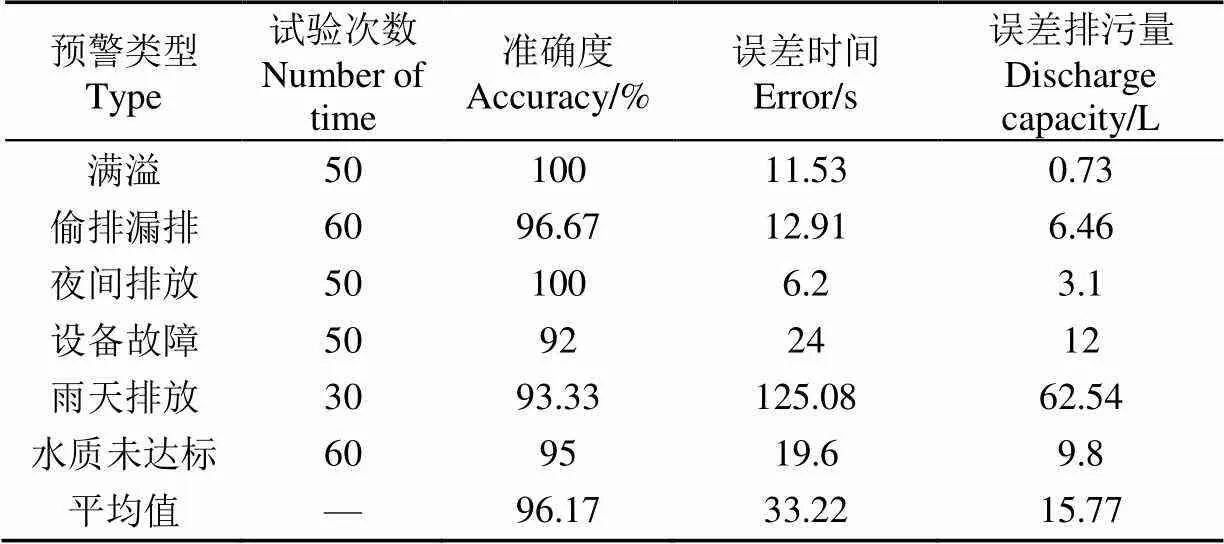
表5 模拟试验结果
4 结 论
本文分析了生猪养殖企业污水治理的实际情况和排放流程,制定3种治理模式下生猪养殖污水智慧监管策略,设计并实现了基于畜牧业物联网的生猪养殖污水智慧监管系统。
1)本系统实现了对不同污水治理方式的生猪养殖企业的统一监管,通过信息采集终端模块监听与收集养殖污水排放的实时信息,实现养殖污水实时数据的监测、视频监控、预警管理、站点管理等功能。
2)工业治理监管策略基于模糊推理理论,对监管因子进行模糊化及逻辑推理,分别制定了不同监管因子的监管规则及策略,建立5个具有双输入变量的模糊监管子系统。能根据排放污水中污染物含量的监测值判定养殖企业是否违规排污以及违规排污等级。
3)针对污水生态治理,本文提出了Ecological模型,利用定性与定量的分析方法对该治理模式下传感器实时数据进行监管,实现对可能存在的养殖污水偷排漏排、满溢、不适宜时间排放等违规现象的监管。
通过试验结果表明,系统预警平均准确度为96.17%,平均误差时间为33.22 s,因误差时间造成的每种违规排污量平均值为15.77 L,能够满足养殖污水排放监管要求,对提高监管效率具有重要意义。但由于养殖污水对传感器存在不同程度的侵蚀及由传感器精度造成的误差,使得本策略在实施过程中仍存在许多问题。
[1] 祁茂彬,王永行,王忠民. 规模养猪场粪便和污水治理模式的调查与思考[J]. 现代畜牧医,2014(1):48-50.
Qi Maobin, Wang Yonghang, Wang Zhongmin. Investigation and thinking of the management mode of feces and sewage in large scale pig farms[J]. Modern Journal of Animal Husbandry and Veterinary Medicine, 2014(1): 48-50. (in Chinese with English abstract)
[2] 孟祥海,张俊飚,李鹏,等. 畜牧业环境污染形势与环境治理政策综述[J]. 生态与农村环境学报,2014,30(1):1-8.
Meng Xianghai, Zhang Junbiao, Li Peng, et al. Summary of livestock environmental pollution and environmental management polcies[J]. Journal of Ecology and Rural Environment, 2014, 30(1): 1-8. (in Chinese with English abstract)
[3] 赵海涛,李宗宇,颜志俊,等. 填料碳种类对蚯蚓生物工程床净化畜禽养殖污水的影响[J]. 农业工程学报,2016,32(15):213-218.
Zhao Haitao, Li Zongyu, Yan Zhijun, et al. Effects of different types of carbon based filter materials on purification of livestock wastewater by earthworm bioengineering bed[J]. Transaction of the Chinese Society of Agricultural Engineering (Transaction of the CSAE), 2016, 32(15): 213-218. (in Chinese with English abstract)
[4] Patricia Bilotta, Ricardo Luiz Radis Steinmetz, Airton Kunz, et al. Swine effluent post-treatment by alkaline control and UV radiation combined for water reuse[J]. Journal of Cleaner Production, 2017, 140: 1247-1254.
[5] 黄美玲,何庆,黄夏子,等. 小球藻处理养殖污水及其资源化利用研究[J]. 中山大学学报,2010,49(增刊1):89-93.
Huang Meiling, He Qing, Huang Xiazi, et al. Aquaculture wastewater treatment and resource utilizing by chlorella[J]. Acta Scientiarum Naturalium Universitatis Sunyatyeni, 2010, 49(Supp.1): 89-93. (in Chinese with English abstract)
[6] 于涛,成水平,贺锋,等. 基于复合垂直流人工湿地的循环水养殖系统净化养殖效能与参数优化[J]. 农业工程学报,2008,24(2):188-193.
Yu Tao, Cheng Shuiping, He Feng, et al. Performance and optimization of recrirculating aquaculture system combined with integrated vertical-flow constructed wetland[J]. Transaction of the Chinese Society of Agricultural Engineering (Transaction of the CSAE), 2008, 24(2): 188-193. (in Chinese with English abstract)
[7] 张世羊,常军军,高毛林,等. 曝气对垂直流湿地水产养殖废水脱氮的影响[J]. 农业工程学报,2015,31(9):235-241.
Zhang Shiyang, Chang Junjun, Gao Maolin, et al. Impact of artificial aeration on nitrogen removal from aquaculture wastewater treated by vertical-flow constructed wetland[J]. Transaction of the Chinese Society of Agricultural Engineering (Transaction of the CSAE), 2015, 31(9): 235-241. (in Chinese with English abstract)
[8] 何金成,杨祥龙,王立人,等. 基于近红外光谱法的废COD、BOD5、PH的快速测量[J]. 环境科学学报,2007,27(12):2105-2108.
He Jincheng, Yang Xianglong, Wang Liren, et al. Rapid determination of chemical oxygen demand (COD), biochemical oxygen demand (BOD5) and PH in wastewater using near infrared spectroscopy[J]. Acta Scientiae Circumstantiae, 2007, 27(12): 2105-2108. (in Chinese with English abstract)
[9] 郭劲松,林佳琪,方芳,等. 屏蔽氯离子干扰高盐榨菜废水中COD的测定方法[J]. 重庆大学学报,2014,37(1):117-122.
Guo Jingsong, Lin Jiaqi, Fang Fang, et al. The chloride mask in COD determination of pickled mustard wastewater with high salt[J]. Journal of Chongqing University, 2014, 37(1): 117-122. (in Chinese with English abstract)
[10] 王俊荣,韩永红,刘宗斌. 银盐沉淀-铬酸盐法测定高氯离子水样中化学需氧量[J]. 冶金分析,2008,28(3):43-45.
Wang Junrong, Han Yonghong, Liu Zongbin. Determination of chemical oxygen demand of high concentration chloride water samples by silver precipitation and dichromate method[J]. Metallurgical Analysis, 2008, 28(3): 43-45. (in Chinese with English abstract)
[11] Matcalf, Eddy, Inc. Wastewater Engineering: Treatment, Disposal, Reuse[M]. 3rd Ed. New York, USA: McGraw-Hill, 1991.
[12] 韩红桂,陈治远,乔俊飞,等. 基于区间二型模糊神经网络的出水氨氮软测量[J]. 化工学报,2017,68(3):1032-1040.
Han Honggui, Chen Zhiyuan, Qiao Junfei, et al. Soft-sensor method for effluent ammonia nitrogen based on interval type-2 fuzzy neural networks[J]. CIESC Journal, 2017, 68(3): 1032-1040. (in Chinese with English abstract)
[13] 许玉格,刘莉,曹涛. 基于Fast-RVM的在线软测量预测模型[J]. 化工学报,2015,66(11):4540-4545.
Xu Yuge, Liu Li, Cao Tao. On-line soft measuring model based on Fast-RVM[J]. CIESC Journal, 2015, 66(11): 4540-4545. (in Chinese with English abstract)
[14] 丛秋梅,苑明哲,王宏. 基于稳定Hammerstein模型的在线软测量建模方法及应用[J]. 化工学报,2015,66(4):1380-1387.
Cong Qiumei, Yuan Mingzhe, Wang Hong. On-line soft sensor based on stable Hammerstein model and its applications[J]. CIESC Journal, 2015, 66(4): 1380-1387. (in Chinese with English abstract)
[15] Li Tianling, Winnel Melissa, Lin Hao, et al. A reliable sewage quality abnormal event monitoring system[J]. Waster Research, 2017, 121: 248-257.
[16] 熊本海,杨振刚,杨亮,等. 中国畜牧业物联网技术应用研究进展[J]. 农业工程学报,2015,31(增刊1):237-246.
Xiong Benhai, Yang Zhengang, Yang Liang, et al. Review on application of Internet of Things technology in animal husbandry in China[J]. Transactions of the Chinese Society of Agricultural Engineering(Transaction of the CSAE), 2015, 31(Supp.1): 237-246. (in Chinese with English abstract)
[17] Li Hualong, Li Miao, Zhan Kai, et al. Intelligent monitoring system for laminated henhouse based on Internet of Things[J]. Transactions of the Chinese Society of Agricultural Engineering (Transaction of the CSAE), 2015, 31(Supp.2): 210-215.
[18] 段玉瑶,马丽,刘刚. 基于物联网的生猪运动行为及猪舍环境远程监控系统[J]. 农业工程学报,2015,31(增刊2):216-221.
Duan Yuyao, Ma Li, Liu Gang. Remote monitoring system of pig motion behavior and piggery environment based on Internet of Things[J]. Transactions of the Chinese Society of Agricultural Engineering (Transaction of the CSAE), 2015, 31(Supp.2): 216-221. (in Chinese with English abstract)
[19] 朱虹,李爽,郑丽敏,等. 生猪养殖场无线传感器网络路径损耗模型的建立与验证[J]. 农业工程学报,2017,33(2):205-212.
Zhu Hong, Li Shuang, Zheng Limin, et al. Modeling and validation on path loss of WSN in pig breeding farm[J]. Transactions of the Chinese Society of Agricultural Engineering (Transaction of the CSAE), 2017, 33(2): 205-212. (in Chinese with English abstract)
[20] 陈长喜,许晓华. 基于物联网的肉鸡可追溯与监管平台设计与应用[J]. 农业工程学报,2017,33(5):224-231.
Chen Changxi, Xu Xiaohua. Design and application of traceability and supervision platform for broiler based on Internet of Things[J]. Transactions of the Chinese Society of Agricultural Engineering (Transaction of the CSAE), 2017, 33(5): 224-231. (in Chinese with English abstract)
[21] 李慧,刘星桥,李景,等. 基于物联网Android平台的水产养殖远程监控系统[J]. 农业工程学报,2013,29(13):175-181.
Li Hui, Liu Xingqiao, Li Jing, et al. Aquaculture remote monitoring system based on IOT Android platform[J]. Transactions of the Chinese Society of Agricultural Engineering (Transaction of the CSAE), 2013, 29(13): 175-181. (in Chinese with English abstract)
[22] 马从国,赵德安,王建国,等. 基于无线传感器网络的水产养殖池塘溶解氧智能监控系统[J]. 农业工程学报,2015,31(7):193-200.
Ma Congguo, Zhao Dean, Wang Jianguo, et al. Intelligent monitoring system for aquaculture dissolved oxygen in pond based on wireless sensor network[J]. Transactions of the Chinese Society of Agricultural Engineering (Transaction of the CSAE), 2015, 31(7): 193-200. (in Chinese with English abstract)
[23] 谢秋菊,苏中滨,Ni Ji-Qin, 等. 密闭式猪舍多环境因子调控系统设计及调控策略[J]. 农业工程学报,2017,33(6):163-170.
Xie Qiuju, Su Zhongbin, Ni Ji-Qin, et al. Control system design and control strategy of multiple environmental factors in confined swine building[J]. Transactions of the Chinese Society of Agricultural Engineering (Transaction of the CSAE), 2017, 33(6): 163-170. (in Chinese with English abstract)
[24] 张伟,何勇,裘正军,等. 基于无线传感网络与模糊控制的精细灌溉系统设计[J]. 农业工程学报,2009,25(增刊2):7-12.
Zhang Wei, He Yong, Qiu Zhengjun, et al. Design of precision irrigation system based on wireless sensor network and fuzzy control[J]. Transactions of the Chinese Society of Agricultural Engineering (Transaction of the CSAE), 2009, 25(Supp.2): 7-12. (in Chinese with English abstract)
[25] 张伶鳦,王润涛,张长利,等. 基于调亏理论和模糊控制的寒地水稻智能灌溉策略[J]. 农业工程学报,2016,32(13):52-58.
Zhang Lingyi, Wang Runtao, Zhang Changli, et al. Intelligent irrigation strategy based on regulated deficit theory and fuzzy control for rice in cold region[J]. Transactions of the Chinese Society of Agricultural Engineering (Transaction of the CSAE), 2016, 32(13): 52-58. (in Chinese with English abstract)
[26] 余国雄,王卫星,谢家兴,等. 基于物联网的荔枝园信息获取与智能灌溉专家决策系统[J]. 农业工程学报,2016,32(20):144-152.
Yu Guoxiong, Wang Weixing, Xie Jiaxing, et al. Information acquisition and expert decision system in litchi orchard based on internet of things[J]. Transactions of the Chinese Society of Agricultural Engineering (Transaction of the CSAE), 2016, 32(20): 144-152. (in Chinese with English abstract)
[27] 丁加丽,彭世彰,徐俊增,等. 基于Penman-Monteith方程的节水灌溉稻田蒸散量模型[J]. 农业工程学报,2010,26(4):31-35.
Ding Jiali, Peng Shizhang, Xu Junzeng, et al. Estimation of rice evapotranspiration under controlled irrigation by using Penman-Monteith method[J]. Transactions of the Chinese Society of Agricultural Engineering (Transaction of the CSAE), 2010, 26(4): 31-35. (in Chinese with English abstract)
[28] Gong Xuwen, Liu Hao, Sun Jingsheng, et al. A proposed surface resistance model for Penman-Monteith formula to estimate evapotranspiration in a solar greenhouse[J]. Journal of Arid Land, 2017, 9(4): 530-546.
[29] 符娜,宋孝玉,夏露,等. 云南省不同生态水文分区参考作物蒸散量算法适用性评价[J]. 农业机械学报,2017,48(5):209-217.
Fu Na, Song Xiaoyu, Xia Lu, et al. Adaption evaluation for reference evaportranspiration calculation methods in different eco-hydrological regionalization of Yunnan province[J]. Transactions of the Chinese Society for Agricultural Machinery, 2017, 48(5): 209-217. (in Chinese with English abstract)
[30] 符娜,李闯,刘艳伟,等. 基于灌溉需求指数的滇中地区烤烟需水量时空变化分析[J].农业机械学,2016,47(4):155-161.
Fu Na, Li Chuang, Liu Yanwei, et al. Temporal and spatial variation analysis of water requirement of tobacco in Middle of Yunnan Province Based on Irrigation Requirement Index[J]. Transactions of the Chinese Society for Agricultural Machinery, 2016, 47(4): 155-161. (in Chinese with English abstract)
Design and implementation of smart supervisory system for sewage emission in swine breeding industry
Wu Xinmei, Xu Aijun, Zhou Suyin※
(1.,311300,;2.,311300,)
Swine effluent poses not only serious threats to the environment and soil but also affect the sustainable development of livestock industry. So the treatment and supervision of swine sewage is imperative. In this paper, we divided the swine treatment methods into ecological treatment, industrial treatment and centralized treatment. To realize the remote monitoring and illegal discharge warning of swine effluent disposed by the three treatment methods, a smart supervisory system and real time data supervisory strategy was designed and proposed. Based on Internet, the newly developed system collected and monitored the effluent information such as rainfall, level, flow, location, chemical oxygen demand and biochemical oxygen demand in water, ammonia concentration and so on through data acquisition system. The system was mainly comprised of sensors, microprocessors, and GPRS wireless transmission module. The collected data were transmitted to the cloud server as real-time data for the entire supervisory system. According to the change rules of data and the practical demand of supervision, real-time data was obtained every 10 minutes. In addition, to determine the credit rating of the industries and push the alarm information in different conditions, the system would select the principle identity as the primary index of warning decision, while for the real-time warning, industry credit rating, alarm grade, and alarm processing time as the secondary indexes were used. Furthermore, the index system of warning-push was proposed in this paper. Combing the real time data and index system of warning-push, the system could realize functions of real time data monitoring, video monitoring, site management, equipment management, data statistic and early warning management. A lower inter-module coupling and a higher cohesion between the functions were designed to improve its scalability and flexibility, and to ensure that the modules could be interrelated in the logical structure and independent in the physical structure. In the centralized treatment, the system used the GPS data and basic information of sewagedisposalplant to judge whether the tank car took the sewage to the designated place to discharge it or not. Based on fuzzy reasoning theory, the supervisory system of industrial treatment with five monitoring subsystems, which had two inputs and one output variables, was established. In this fuzzy supervisory system, suspended solid difference, ammonia-nitrogen difference, biochemicaloxygendemand difference, chemical oxygen demand difference, total phosphorus difference and its variation rate were selected as input variables, and corresponding warning rank as an output variables. Also, symmetry triangle was selected as the membership function of input and output variables to ensure the sensitivity and robustness of the system. According to the effluent discharge standards of the livestock and poultry industry, fuzzy reasoning rules of the subsystem can be generated. To monitor the ecological treatment of swine effluent, in this paper, we constructed the corresponding supervision strategy and ecological mathematical model. Based on the principle of the supervisory strategy, the model predicted and analyzed the real-time data by qualitative and quantitative method to calculate the discharging interval during rainy days and to judge whether there existed the phenomenon of night discharge, stealing and leaking, overflowing and so on. Through the simulation test, the results showed that the system’s average warning accuracy reached 96.17%, the average error time was 33.22 s, the illegal discharge capacity caused by error time was 15.77 L. Therefore, this supervisory system could meet the requirements of swine effluent discharge regulation and improve the supervision efficiency significantly.
sewage; emission control; design; swine production; fuzzy reasoning; smart supervision; supervisory system
10.11975/j.issn.1002-6819.2018.02.031
S818.9
A
1002-6819(2018)-02-0226-09
2017-09-11
2017-12-29
浙江省“三农六方”科技协作项目(CTZB-F160728AWZ-SNY1,生猪养殖污染治理智慧监控技术模式研究与应用)
武新梅,从事资源与环境信息系统研究。Email:xinmeiw@foxmail.com
周素茵,讲师,从事电子电路的分析与设计及物联网方向的研究。Email:zsy197733@163.com
武新梅,徐爱俊,周素茵. 生猪养殖业污水排放智慧监管系统的设计与实现[J]. 农业工程学报,2018,34(2):226-234. doi:10.11975/j.issn.1002-6819.2018.02.031 http://www.tcsae.org
Wu Xinmei, Xu Aijun, Zhou Suyin. Design and implementation of smart supervisory system for sewage emission in swine breeding industry[J]. Transactions of the Chinese Society of Agricultural Engineering (Transactions of the CSAE), 2018, 34(2): 226-234. (in Chinese with English abstract) doi:10.11975/j.issn.1002-6819.2018.02.031 http://www.tcsae.org

